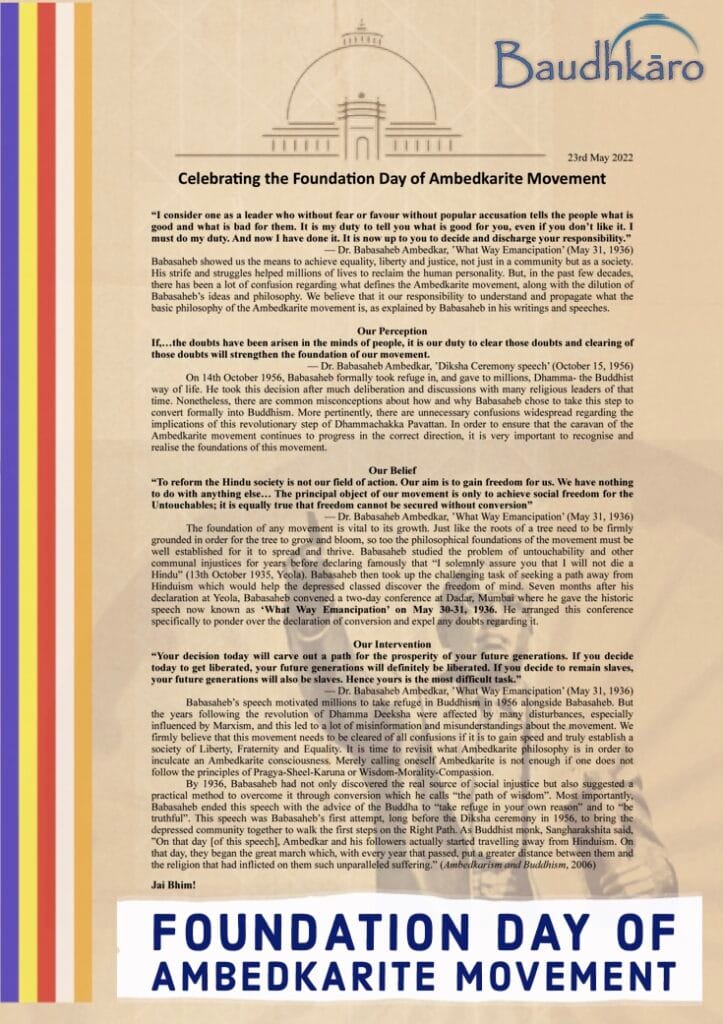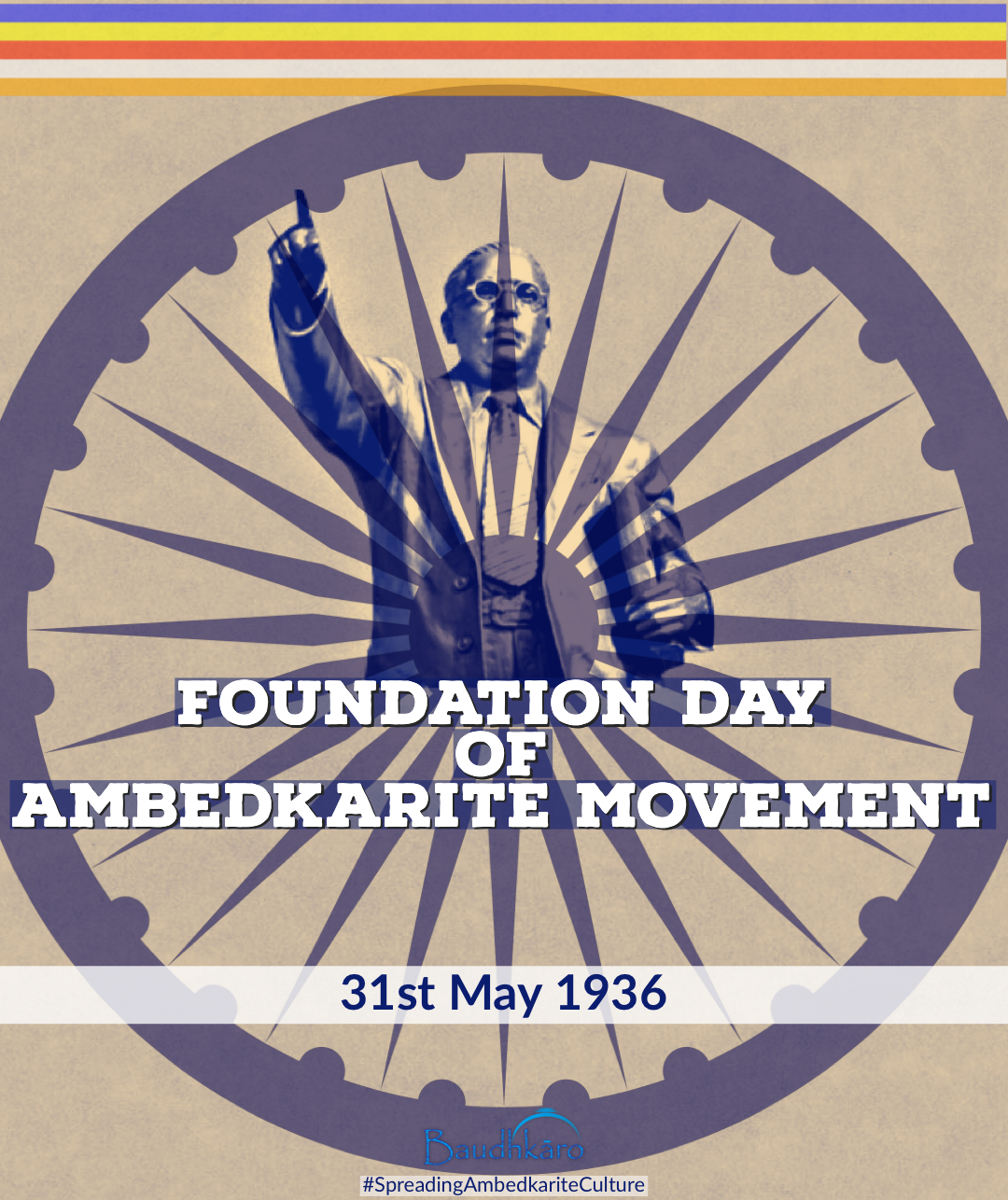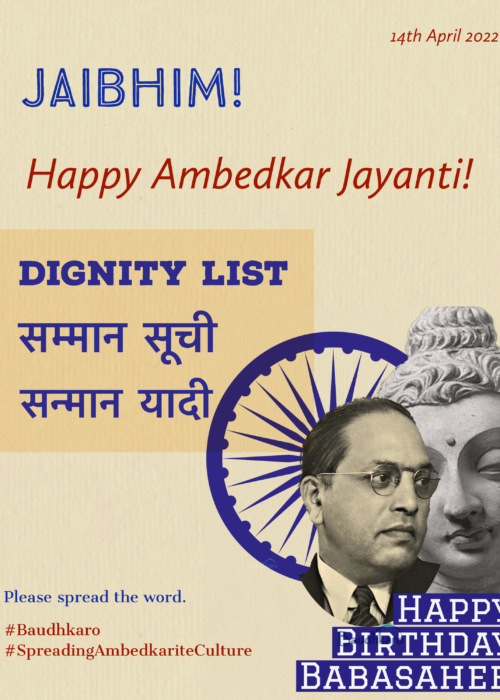
“I consider one as a leader who without fear or favour without popular accusation tells the people what is good and what is bad for them. It is my duty to tell you what is good for you, even if you don’t like it. I must do my duty. And now I have done it. It is now up to you to decide and discharge your responsibility.”
— Dr. Babasaheb Ambedkar, ’What Way Emancipation’ (May 31, 1936)
Babasaheb showed us the means to achieve equality, liberty and justice, not just in a community but as a society. His strife and struggles helped millions of lives to reclaim the human personality. But, in the past few decades, there has been a lot of confusion regarding what defines the Ambedkarite movement, along with the dilution of Babasaheb’s ideas and philosophy. We believe that it our responsibility to understand and propagate what the basic philosophy of the Ambedkarite movement is, as explained by Babasaheb in his writings and speeches.
Our Perception
“If…the doubts have been arisen in the minds of people, it is our duty to clear those doubts and clearing of those doubts will strengthen the foundation of our movement.”
— Dr. Babasaheb Ambedkar, ’Diksha Ceremony speech’ (October 15, 1956)
On 14th October 1956, Babasaheb formally took refuge in, and gave to millions, Dhamma- the Buddhist way of life. He took this decision after much deliberation and discussions with many religious leaders of that time. Nonetheless, there are common misconceptions about how and why Babasaheb chose to take this step to convert formally into Buddhism. More pertinently, there are unnecessary confusions widespread regarding the implications of this revolutionary step of Dhammachakka Pavattan. In order to ensure that the caravan of the Ambedkarite movement continues to progress in the correct direction, it is very important to recognise and realise the foundations of this movement.
Our Belief
“To reform the Hindu society is not our field of action. Our aim is to gain freedom for us. We have nothing to do with anything else… The principal object of our movement is only to achieve social freedom for the Untouchables; it is equally true that freedom cannot be secured without conversion”
— Dr. Babasaheb Ambedkar, ’What Way Emancipation’ (May 31, 1936)
The foundation of any movement is vital to its growth. Just like the roots of a tree need to be firmly grounded in order for the tree to grow and bloom, so too the philosophical foundations of the movement must be well established for it to spread and thrive. Babasaheb studied the problem of untouchability and other communal injustices for years before declaring famously that “I solemnly assure you that I will not die a Hindu” (13th October 1935, Yeola). Babasaheb then took up the challenging task of seeking a path away from Hinduism which would help the depressed classed discover the freedom of mind. Seven months after his declaration at Yeola, Babasaheb convened a two-day conference at Dadar, Mumbai where he gave the historic speech now known as ‘What Way Emancipation’ on May 30-31, 1936. He arranged this conference specifically to ponder over the declaration of conversion and expel any doubts regarding it.
Our Intervention
“Your decision today will carve out a path for the prosperity of your future generations. If you decide today to get liberated, your future generations will definitely be liberated. If you decide to remain slaves, your future generations will also be slaves. Hence yours is the most difficult task.”
— Dr. Babasaheb Ambedkar, ’What Way Emancipation’ (May 31, 1936)
Babasaheb’s speech motivated millions to take refuge in Buddhism in 1956 alongside Babasaheb. But the years following the revolution of Dhamma Deeksha were affected by many disturbances, especially influenced by Marxism, and this led to a lot of misinformation and misunderstandings about the movement. We firmly believe that this movement needs to be cleared of all confusions if it is to gain speed and truly establish a society of Liberty, Fraternity and Equality. It is time to revisit what Ambedkarite philosophy is in order to inculcate an Ambedkarite consciousness. Merely calling oneself Ambedkarite is not enough if one does not follow the principles of Pragya-Sheel-Karuna or Wisdom-Morality-Compassion.
By 1936, Babasaheb had not only discovered the real source of social injustice but also suggested a practical method to overcome it through conversion which he calls “the path of wisdom”. Most importantly, Babasaheb ended this speech with the advice of the Buddha to “take refuge in your own reason” and to “be truthful”. This speech was Babasaheb’s first attempt, long before the Diksha ceremony in 1956, to bring the depressed community together to walk the first steps on the Right Path. As Buddhist monk, Sangharakshita said, ”On that day [of this speech], Ambedkar and his followers actually started travelling away from Hinduism. On that day, they began the great march which, with every year that passed, put a greater distance between them and the religion that had inflicted on them such unparalleled suffering.” (Ambedkarism and Buddhism, 2006)
JAI BHIM!
Babasaheb’s speech- What Way Emancipation




